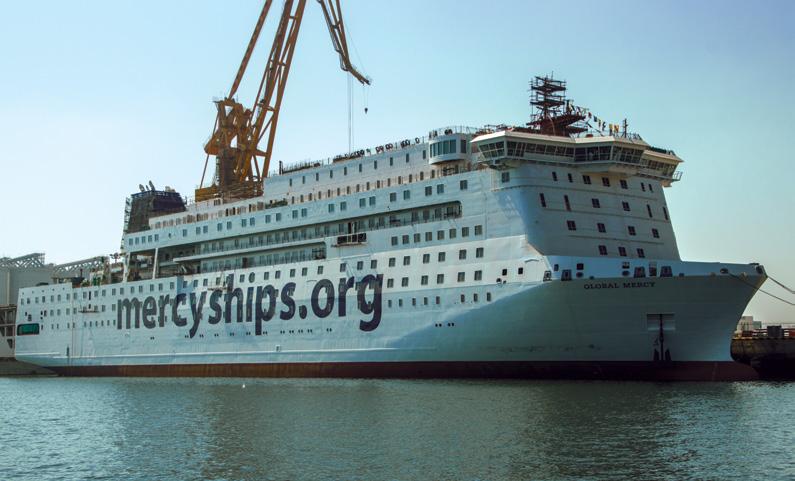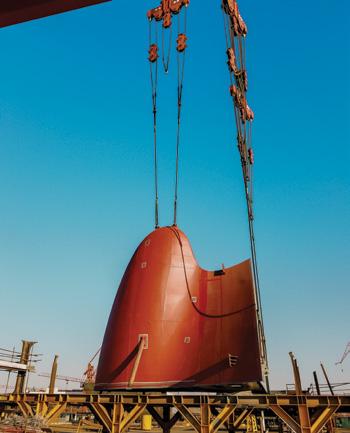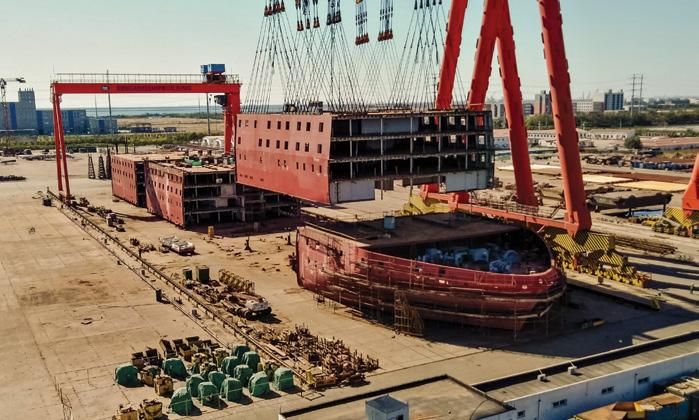
8 minute read
Mercy Ships nears completion of the Global Mercy
by CILTNZ
The hospital ship Global Mercy will provide free services to more than 150,000 people in Sub-Saharan Africa over the vessel’s expected 50-year service
SHIP BUILDING
Expanding mercy – Mercy Ships nears completion of the MV Global Mercy
By Janine Stewart and Irene Kim. All photos courtesy of Mercy Ships
RESEARCH HAS continuously emphasised the increasing need for medical and surgical care around the world, especially in Africa. More than 5 billion people worldwide do not have access to safe surgeries, and now with the impacts of Covid-19, the global backlog of surgical care has escalated. Along with the Africa Mercy, the Global Mercy™ will change numerous lives by providing free essential surgery, medical training and mentoring, all of which will significantly impact the healthcare capacity of the Sub-Saharan region.
About Mercy Ships
Mercy Ships uses hospital ships to deliver free, world-class healthcare services, capacity building, and sustainable development to those with little access in the developing world. Founded in 1978 by Don and Deyon Stephens, Mercy Ships has worked in more than 55 developing countries, providing services valued at more than NZ$2.55 billion and directly benefitting more than 2.84 million people. The ships are crewed by volunteers from over 60 nations, with an average of more than 1200 volunteers each year. Professionals including surgeons, dentists, nurses, healthcare trainers, teachers, cooks, seamen, engineers, and agriculturalists donate their time and skills. With 16 national offices and an Africa bureau, Mercy Ships seeks to transform individuals and serve nations.
www.mercyships.org.nz
The recently constructed Global Mercy is the world’s only non-governmental purpose-built hospital ship. At 174 m in length, 7000 sq m in area and 37,000 gross tonnage, it is twice the size of the Africa Mercy, a former passenger ferry which was acquired by Mercy Ships in 1999 and refurbished specifically as a hospital ship to serve surgery and health needs in Africa. Now in 2020, the newly constructed Global Mercy is nearing completion to further expand on the impact that Mercy Ships has in the African continent. Unlike the Africa Mercy, the Global Mercy is an original build, which presented new and unique challenges.
This article discusses the processes and challenges of designing and building the Global Mercy, key issues from a contracting and construction perspective, technical and operational challenges, and how Covid-19 has impacted the Global Mercy. In writing this article, we interviewed former chief information officer of Mercy Ships and now managing director of the Global Mercy, Chris Gregg, who was directly involved in bringing the ship into operation.
Procurement and construction considerations
From a contracting perspective, it is interesting to consider how the procurement of a hospital ship compares to that of a land-built hospital. Ultimately, with the Global Mercy it came down to the need for specialised design and contracting skills which needed to be balanced against the control Mercy Ships required over the specifications, given the charity’s extensive experience in operating hospital ships.
For the Global Mercy, Mercy Ships completed the concept design and specifications for the ship in the first instance. These were strict and extensive to ensure the specialities of a hospital ship were met. The specifications focused on maximum space and size for training purposes, and capacity for serving and operating on patients.
The Mercy Ships concept was blended with a design for a ropax ferry – a roll on/roll off (ro-ro) vessel built for freight transport, but with passenger accommodation – which Stena had been developing. Deltamarin, a specialist marine design company, who had worked on the Stena concept, were also involved in the blended concept that became the Global Mercy. This was the concept package that was sent for tender to various shipyards.
A design and build contract was subsequently entered into with CSSC – the China State Shipbuilding Company – who subcontracted the design to Deltamarin. It was crucial to rely on the specialty of the contractor and subcontractor for this entirely purpose-built ship.

Components for the Global Mercy being manoeuvred in the shipyard
Throughout the process, Mercy Ships retained control of the information technology design aspects of the ship build. This was to ensure the implementation of the latest technology to ensure the most efficient operation of the ship as a hospital. For example, the Global Mercy has six operating theatres which require specialised technology. Further, medical staff onboard are able to run video training sessions from the operating room.
Video links
Watch a 30-second time-lapse of the Global Mercy shipyard build here – https://bit.ly/3mR7Rik
Watch a four-minute information video on the Global Mercy here – https://bit.ly/2Gp0fUv
The information technology for a hospital ultimately rests on efficiency as well as excellence. Most of the technology onboard, such as the training suite and simulation lounge, is focused on capturing what is happening, recording playback, and being able to ‘walk back’ for training purposes. All communications and most of the hospital functions are built on information technology. Compared to 800 network connections on the Africa Mercy, the Global Mercy has 4000 network connections and thus requires a significantly larger technical capability. Many features function on a separate system on the Africa Mercy, such as CCTVs and TV in cabins. However, these now operate on one system for the Global Mercy.
Other interesting features include LED lighting, variable frequency drives on electric motors, and reprocessing of water condensate for laundry. A big focus of the Global Mercy is on training, with two simulator rooms (approximately 90 sq m) with virtual and augmented reality, mannequins and other training tools, and a training debriefing room (approximately 30 sq m). The capital campaign in New Zealand also raised approximately $1 million for the build of the intensive care unit (approximately 80 sq m). The ship will also feature a 682-seat auditorium, an accredited school for children, a gymnasium, pool, café and library.

The Africa Mercy was originally a passenger ferry and was acquired by Mercy Ships in 1999 and refurbished as a hospital ship
The Global Mercy has taken approximately five years to build at the Tianjin Xingang Shipyard in China. The first steel cut was done in September 2015, and the keel was laid in December 2015. Compared to the usual land-based hospital construction, the building of the Global Mercy was especially unique with even more significant health and safety considerations. For example, the Global Mercy has medical gas/oxygen that is piped throughout the hospital. This system required special attention and fire protection measures from a maritime perspective, balancing the fire risk of pumping oxygen around the ship with the gas supply needs of the hospital.
The use of prefabrication also warrants discussion. This included assembling major components of the ship’s structure at a manufacturing site and transporting the complete assemblies to the construction site. This practice was used extensively for the Global Mercy, including for the hull. The steel was cut into individual pieces and assembled into sections which were then put together in blocks. The blocks were landed into the dry dock and assembled into the ship. Prefabrication was also used for the ship’s ‘wet units’ – the bathrooms, including toilet, sink and shower.

The design for the Global Mercy utilised modular construction technology
The Global Mercy was designed to align with the hospital ship charity’s commitment to sustainability. It meets maritime requirements for low-sulphur emissions, and the systems provide reliable and efficient power. There is a system to filter and treat airconditioning condensate water for technical use. This will reduce potable water use by 50%. There is also a high-efficiency airconditioning system which will reduce total energy consumption by 15%.
Challenges in bringing Global Mercy into operation
The process of bringing any project into operation has its challenges and this was particularly so in mobilising the Global Mercy. For example, ensuring the safe and staggered boarding of people on the ship requires a detailed plan with an incremental process. This involves ensuring there are sufficient hotel services such as a gallery and dining room to support the staged onboarding of crew and avoid overcrowding.
Current estimates are that the Global Mercy will have 40 containers of supplies loaded onto it after completion. Outfitting of medical equipment will also be required. Completing these requirements in a safe and efficient manner will be a focus for Mercy Ships. Another potential challenge is noise which was an issue for the Africa Mercy.
The Global Mercy will operate in the Sub-Saharan region of Africa, complementing the work of the Africa Mercy. The ships will operate on a staggered cycle of six months, ensuring there is always one vessel in service. The ships are required to undergo annual maintenance, and the staggered approach allows an alternative ship to operate during that time. Helpfully, the maintenance periods of the Global Mercy will be shorter and less frequent.
Mercy Ships has a country engagement plan with a five-year cycle. This begins with developing a plan with the nation’s Ministry of Health to strengthen their healthcare systems, includes a ten-month ship field service of surgical delivery and mentoring, and concludes with collaborative, in-depth assessment and evaluation. Mercy Ships will match up host country requirements to best fit each of the ships as the Global Mercy will have greater surgical and training capacity.
Covid-19
The outbreak of Covid-19 has presented Mercy. The ship was built in China where a lockdown of three months was initiated on 23 January 2020. Works paused during this time, but resumed as soon as possible locally.
Transporting staff to China has also been difficult, but Scandinavian and Chinese staff on the site have continued with approval processes and construction. Mercy Ships will mobilise the Global Mercy into service as soon as possible, in a Covid-19 secure manner, while safely bringing in volunteers from across the world.
Conclusion
The Global Mercy is scheduled to begin the journey to Africa in 2021, and will soon undergo sea trials. The first field service location will be in West Africa, providing desperately needed operations for people who have no other access to the help they need.
Despite the various challenges faced, the Global Mercy will soon be ready to provide life-changing services. Mercy Ships is still in search of medical, maritime and operational volunteers to help double the impact for those in need. For further information on this remarkable opportunity and challenges to the launch of the Global inspiring organisation, visit their website.
Janine Stewart is the board chair of Mercy Ships New Zealand; she is a specialist construction and property lawyer, leading the MinterEllisonRuddWatts construction team, in which Irene Kim is a solicitor





